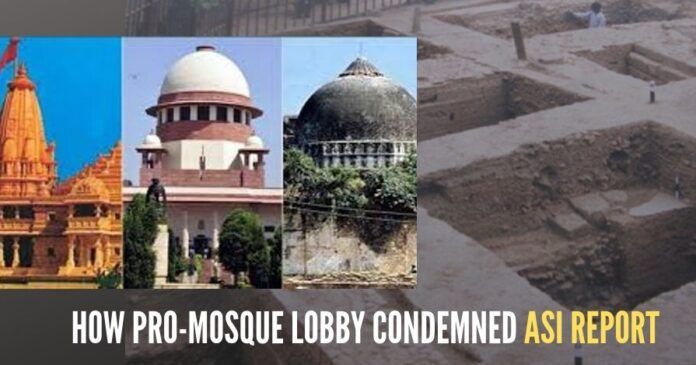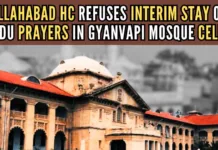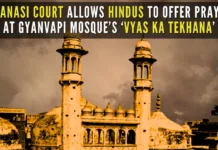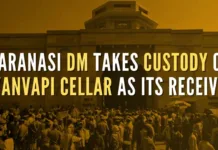
Even before the ASI submitted its final report, one of these historians, Irfan Habib condemned the ASI in a newspaper article
With less than a month to go before the parties have to wind up their arguments on the Ayodhya dispute case before the Supreme Court, the desperation of the Muslim parties is evident. On September 25, lawyers for the Muslim side questioned the credibility of a 2003 excavation report of the Archeological Survey of India, arguing that since no one had signed it, the report’s correctness remained in doubt.
As the court pointed out, it seemed rather late in the day to rake up the issue. It must be remembered that the Muslim parties, which include the Sunni Waqf Board, had not pursued the matter before the Allahabad High Court which had pronounced its verdict almost a decade ago. It had not sought to summon the officials of the ASI to counter them with their (Muslim parties’) claims of the “glaring inconsistencies” and “mistakes” which have been made before the Bench of the apex court.
The High Court came down heavily on these so-called experts — it referred to them as “alleged experts” — and said they had been “preparing a kind of anticipatory ground to assail the ASI people, their proceedings and report”
That said, what did the ASI report say and how did the report come about? In March 2003, a special three-judge (Lucknow) Bench of the Allahabad High Court directed the ASI to undertake excavations at the site where the Babri mosque once stood. The court opined that the findings of the excavation would be important in deciding the dispute that had been waging for decades. The ASI conducted excavations between March 2003 and August 2003 on the basis of an earlier Ground Penetrating Radar survey of the area. The GPR survey had indicated at material possibly associated with ancient structures, and it was for the ASI to either confirm or deny those possibilities.
The ASI’s report was submitted to the High Court in the third week of September 2003. The superintending Archaeologist and team leader, Dr BR Mani, observed that the ASI had done its work with a “limited but defined” objective set by the court. The entire process of excavation was recorded by still and video cameras. All the excavated materials were sealed in the presence of the disputing partisan kept strong room.
In the process of collecting the excavated material, as many as 90 trenches were dug up. The site was divided into five segments and the excavation was done in phases.
The main findings were as follows: One, a round bezel in the greenish glass with the legend of sidhe in Ashokan Brahmi on the obverse; two, a big kiln, besides animal and human figurines, bangle fragments; massive brick construction; remains of a large structure, nearly 50 metres in the north-south orientation. But perhaps the most significant finding was that almost 50 pillar bases with brickbat foundations, below the concrete blocks topped by sandstone blocks were unearthed. Of the 50, twelve had been completely exposed— the rest being either partially exposed or exposed in sections. It was over this earlier massive structure, the ASI concluded, that the mosque had come to be built.
The ASI report, after running through the various findings that covered a range of periods — from the Shunga period to the Gupta reign to the era of the Rajputs to the post-Rajput times and the advent of the Mughals — concluded as follows:
“Viewing in totality and taking into account the archaeological evidence of a massive structure just below the disputed structure and evidence of con tenuity in structural phases from the tenth century onwards up to the construction of the disputed structure, along with the yield of… fifty pillar bases in the association of the huge structure, are indicative remains which are distinctive features found associated with the temples of north India.”
Simply stated, the ASI report said that the Babri mosque had not been built on virgin land but had come up after bringing down an earlier structure that had features associated with temples of north India.
Despite the ASI conducting its excavations under the supervision of the Allahabad High Court, meticulously recording and preserving its findings, and keeping the warring parties informed about them at every stage of the excavations, the pro-Babri mosque groups continued to attack the ASI, during and after the excavations were completed. The Central Sunni Waqf Board had presented eight historians as experts in excavations, besides a few more who assisted from the outside. Even before the ASI submitted its final report, one of these historians, Irfan Habib condemned the ASI in a newspaper article. He wondered whether the agency was pre-determined to establish the presence of a temple at the site of the dispute. He rubbished the presence of pillar bases, saying that they could just be “low seats” or “markers” for shops. He also claimed that the pillar bases were “easy to assemble” — meaning they had been brought from outside and placed at the disputed site. He seemed to have forgotten that the excavations had been conducted under the watchful eyes of video cameras and the evidence, soon as they were excavated, were shared with the disputing parties.
Another Left-leaning historian, Suraj Bhan, said that earlier Sultanate mosques had pillar bases, and it was possible that the Babri structure had come upon one such sultanate era mosque. “There was no temple”, he declared grandly. Yet another pro-Babri lobby historian, RC Thakran, termed the ASI report as an “unprofessional document, full of gross omissions, one-sided presentation evidence, clear falsifications and motivated inferences”.
Interestingly, with the exception of Suraj Bhan, none of these experts had any experience in excavations or field archaeology. Thakran told the court that he was a “just a table archaeologist”, while another confessed that he had “acquired knowledge of archaeology” and did not have a professional degree or diploma in the area of work. And yet, these self-trained archaeologists had no hesitation in critiquing the work of professionals of the ASI, making profound remarks that even trained archaeologist would be careful with. They found “shortcomings” in the ASI’s report and doubted the antiquity register maintained by the excavation experts.
The High Court came down heavily on these so-called experts — it referred to them as “alleged experts” — and said they had been “preparing a kind of anticipatory ground to assail the ASI people, their proceedings and report”. One of the historians sheepishly admitted that he had “formed my opinion prior to submission of the ASI’s report”. Remarkably, this very historian had earlier said that there was no need for excavations to resolve the dispute!
From the above, it appears from the recent submissions made before the Supreme Court by the lawyers of the Muslim parties, that they are clinging on to straws.
Note:
1. The views expressed here are those of the author and do not necessarily represent or reflect the views of PGurus.











The left lobby and their lap dog historians like Suraj Bhan, Irfan Habib have virulent anti-Hindu bias. They equate construction of Ram temple to victory for BJP and Hindus. They are least bothered about masjid or anything else. Their only worry is BJP/Modi should not win the Ayodhya case. Even in the face of strong ASI report and K K Mohemmed’s(associated with the excavation in Ayodhya) statements in his biography, the left anti_hindu lobby tries to discredit ASI. They have been dragging the case for 70 years. It is high time SC call their bluff. It is time Indians totally reject these so called ‘liberals’ who are nothing but puppets of anti-India forces
These are same suspiciously White skinned evil deranged bestial demons in human clothing the Commie Mad Dogs who act as champions of Poor, Muslims, Xtians, while their evil demonic Mecca called China, kills people to harvest their organs and even their skins, FOR THEIR WHITE MAA KE YAAR. Debauchery of Bangali, Pakipanjabis and ME gutter cleaning Keralities no doubt give rise to Deranged Commie Pigs of bestiality of unfathomable evil.
N Ram the suspiciously Blue Eyed, White skinned prds of unknown spermFDI, who likes get his light ass kicked by White demonesses is silent on bestiality of China, so are Prakash Karat (Real Father a Brit Theology Professor) and BANGALIN BRENDA with pink white skin and BeefBrahmin RAZAKAR Byproduct SHITPAN LECHURY
Never forget the strong stand taken by K K Mohammed on the temple issue. In his autobiography , Mohammed meticulously exposes the pro-Babri secular mafia and their intents. The truth always triumphs eventually.
This seems to be another problem similar to Kashmir
in the sense that so solution could be reached, each party sticking to its stand, despite sincere efforts to arrive at a compromise.
Excellent article and lovely points that should have cleared the doubts of our genuine Muslim friends.